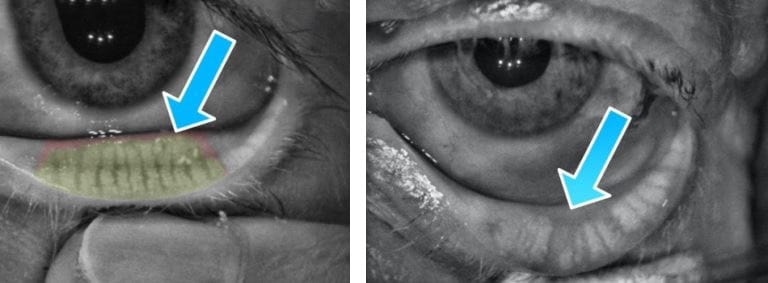Opticians move or flip the eyelid (aka eyelid eversion) to perform a checkup of the eye and the lid itself. This gives the optician or optometrist a better view on:
- Foreign bodies on the eyelid or the eye
- A closer look at the Meibom glands
- Giganto papillary conjunctivitis
- Stained regions as a result of contact lens irritation
- Lid Wiper Epitheliopathy
A comprehensive look at the eye requires the eye care professional to move the lids a little to see more from the eye. With a look at the conjunctiva (the inner part of the lid) of the everted upper lid, the optician can spot abnormalities that could be induced by contact lens wear for example.
With an everted lid the optician can fairly easily see changes in the structures of the conjunctiva. When the surface does not look smooth and the color changed more to a red rather than a pink the optician spotted an abnormality. I
In a lot of cases, it is not necessary to put dyes on the eye to see what caused irritation but in some cases when the contact lens produces more friction the optician can see where the contact lens produces a problem by using lissamine green for example.
With the dye in the eye and the everted lid, he or she can see where the conjunctival structures are irritated by the contacts and therefore gathered more information to improve the fit of the contacts.
Why Do Opticians Pull Your Eyelids Down?
As with the upper lid in some cases the eye care professional need to check if a foreign body slipped under the lower lid. With pulling the eyelid down he or she can fairly easily see if a foreign body or something else causes an irritation on the lids.
For example, the images below show an eye on the left with an eyelid pulled down and the brighter lines in the lid are Meibom glands. In the right picture below you can see the Meibom glands are missing. This infrared scan in an optical shop shows the optician the inner lid of the eyelid which could explain dry eye symptoms for example.

Depending on how the inner part of the eye is structured the optician can then fit different contact lenses or recommend different eye care products to the customer specifically targeted towards the need of the customer.
By pulling the lower lid down the optician can not only see the glands of the lid he or she can also see calcifications that could cause foreign body sensation under the lid due to the changed shape of the inner eyelid. But in some cases the customer has no foreign body stuck in the inner eyelid and no calcification is visible and still, a foreign body sensation can be felt.
Oftentimes dry eyes would benefit from a comprehensive eye exam so the optician checks the lids extensively. When he pulls them down for example it is very easy to see when surface irregularities are visible.
Those irregularities caused for example by an uneven tear film leads to increased friction of the lid of the eye. With every blink of the eye, the tear film gets thinner the lubricity of the tear film gets worse and the friction-related damage can be made visible with dyes like lissamine green.
This dye in combination with an everted lid or a pulled-down one enables the optician to see if further damage to the ocular surface and the lid wiper region can be observed. Depending on the optician’s findings he will then be able to reduce the shearing forces during the blink to give the eye the ability for improved wetting.
For example on possibility would be to choose a contact lens material that would work well with the type of tear film of the customer to reduce lid wiper eliopathy in CL wearers. With a correctly chosen material, those types of friction can be reduced.
The eyelids should be pulled down or up even though when no contacts are worn just to see a little more of the eye. It makes a lot of sense for the optician to look at the eyes and even under the lids to see what could influence the following refraction.
I wish you a great day.
